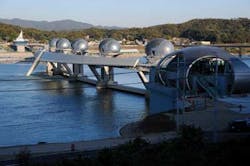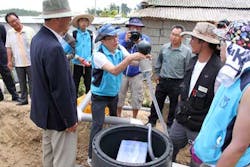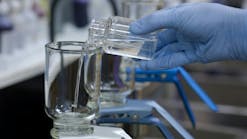A Shining Star in Rainwater Harvesting
With monsoon and drought conditions in quick succession, South Korea has learned the hard way to fully harvest rainwater on a commercial scale for non-potable applications. WWi looks at why the major cities of Daegu and Busan are following in the footsteps of an ambitious project that started in Star City.
South Korea's extraordinary economic success story has co-existed with one of the world's most significant water challenges. This mountainous country's monsoon climate delivers a year's rain in three months, followed by an intense, extended drought. Naturally, both water resources and stormwater management are high on the government's list of priorities.
The most recent example of South Korea's water management strategy has seen Professor Mooyoung Han at work on Kido Island, one of the thousands of tiny islands that dot the south west coast of Korea, overseeing installation of rain tanks that will capture the scarce rainfall and use it for drinking water.
The four cubic meter capacity rainwater tanks have been installed at each of the island's nine houses, he explains, and also at the church. "In the city, this water is good for non-drinking purposes – it saves on water rates and the energy for water supply. In the islands it is the only and best drinking water."
Professor Han is the principal global proponent of rainwater harvesting, and explains that it is a clean, natural source that requires minimal treatment before use – usually for irrigation, but in this instance directly for drinking. Most of all, it is free of charge.
What the rainwater harvesting system is doing on the island is providing an alternative to the only other option, desalination, which the government had been proposing. "Although a long time ago people depended on rainwater, and remember drinking it when they were young, we have moved to other types of supply, often from far away. Now the island people think they are in heaven – the groundwater they were using is very salty, and they had to drink it and use it for washing, but small particles and high Total Dissolved Solids remain that you cannot drink. The water supply was terrible."
Rainwater is collected from the rooftops via gutters, which divert flows to a sedimentation tank. This in turn connects via piping to the rainwater tanks, installed below ground. In the sedimentation tank a 500 micron filter strains particles from the water, and the rainwater tank itself works as a sedimentation basin. It is pumped inside the home and it is used directly for non-drinking purposes, and UV treatment is applied for drinking water. It is an ingenious, decentralized solution to a pressing local issue.
Such a modest system is making a real difference to a tiny group of islanders. The mayor of the county is planning to promote rainwater harvesting to all the 1004 islands in Shinan County for the welfare of the islanders and as a tourist attraction. However, it is just the latest element in a remarkable story that started with an ambitious rainwater harvesting project in Star City which neatly resolved flood, drought and stormwater management issues.
Professor Han remembers: "In Star City some very high rise apartments were planned, and during the design stage a baseball playground at the university got flooded – this is a flood-prone area - so the government was afraid the new building would cause more runoff and more flooding."
The construction company was asked to install a rainwater tank, but did not want to pay the cost. Professor Han says: "I came between, and asked the government for the authority to give more incentive – to allow them to build more floor space. I brought the idea to the construction company, if you make a tank you will get more floor space and you can sell more apartments – the condition is that you have to make a very good design. They invited me, and I designed it."
Three storeys of below-ground parking were planned for the development. Professor Han asked the construction company if it would be possible to add an extra below-ground level to Building B, for use as a rainwater tank, to which the company agreed. The tank was 1500 m2 in area, with a depth of 2 m, creating a 3000 m3 capacity tank. This was divided into three separate units, each with 1000 m3 capacity.
"The first tank was for flood control – if there is heavy rain in the city we can order them to empty the first tank, which means we have a 1000 m3 facility for flood control, it is designed to retain the first 100 mm rainfall," Professor Han explains. "The second tank is used for irrigating the very nice central garden and public toilets. The third tank is always full of fresh water for emergencies – if a water pipe breaks, they can survive for five to ten days. If there is a fire, the firefighters can use this water."
The residents only pay 20c a month for their water supply per housing unit, Professor Han says, which naturally makes them very happy, as does the prospect of not being flooded. "The first tank is for others, the second is for the residents, the third is for all of us," he explains. "Everybody is happy. As it is chlorine free, the plants and grass are happy too. I operated the system and collected data for a year in 2008, and found I can save 40,000 m3of water a year. It also reduced pump energy by 10,000kWh per year, which will make people on small islands happy because climate change is causing the seas to rise."
Professor Han refers to the development of the "waffle theory". He explains: "Star City is one cell of the waffle. If each cell has this system, the whole city can make everyone happy. The whole city is the sum of many waffle cells. If it operates in other cities, the whole country is happy and if other countries follow, the whole world will be happy. This is the first step toward world peace, because it is said that in the 21st century there will be war caused by water."
Certainly, the government was convinced by Star City, and created regulations incorporating rainwater harvesting/stormwater management systems into new buildings. To date, 59 cities throughout the country have followed suit, largely thanks to Professor Han's tireless campaigning, including the capital, Seoul, and the major cities of Incheon, Kwangju, Busan, Daejeon and Daegu. These "rain cities" have now received the backing of legislation in the form of a Water Reuse Law that means all new large and public buildings must incorporate rainwater harvesting systems.
Existing houses can receive a subsidy towards individual systems, and new houses and apartments must also install rainwater tanks. However, Professor Han notes that in existing apartment buildings it is "not easy" to retrospectively install a rainwater harvesting system. In order to gain public acceptance and support, he is planning a demonstration project in an existing building, working with a designer to incorporate the rainwater tank to make it a monument or art work in a street or house. Professor Han has also taken his campaign overseas, and systems have been successfully installed in Vietnam and Indonesia.
He believes rainwater harvesting is the best answer to the sort of problems that South Korea is facing. "I guarantee it is very clean. It has zero mileage. There is no concern about emerging contaminants, such as micropollutants." He strongly believes that rainwater harvesting can provide a decentralized solution for water resource issues, which also happily eliminates the runoff from rooftops that forms a significant element of flooding.
He also believes rainwater could be used more widely for potable purposes, but notes that he doesn't want to fight against the authorities in charge of urban water utilities, who use the rainwater for irrigation. "But if you come to the island, this is the best quality water to drink, needing just sedimentation and final disinfection."
From his experience in promoting rainwater to society, Professor Han developed an innovative idea - that for the city of the future, it is necessary to train the citizens of the city of the future. Dr Lee Hakryul, the mayor of Goseung City, helped him to realise this vision. For the World Dinosaur Expo, held in Goseung earlier this year, he created the slogan "Raindrops say hello to dinosaurs", highlighting the fact that dinosaurs became extinct due to the failure of climate change adaptation.
"Human beings should be aware of the importance of climate change adaptation, for which the biggest concern is rainwater management," Professor Han notes.
The dinosaur and rainwater education campaign was a great success, with 1.8 million visitors over the 73 days of the expo. The expo site itself is a rainwater classroom that collects rainwater from the rooftop and uses it for toilet flushing, as a rainwater curtain and rainwater waterfall.
The exhibition itself was created with the intention of demonstrating the importance of rainwater management. In the rainwater museum, children learned that rainwater is money – it uses less energy - and were shown indigenous wisdom about coping with rainwater, impressions they will take into their future lives.
At the IWA Busan World Water Congress in September 2012, Professor Han and Dr Lee Hakryul will receive an IWA 2012 Project Innovation Award in the field of Marketing and Communication for their work, whose slogan is "Rainwater Revolution: from drain city to rain city by training brain citizens".





